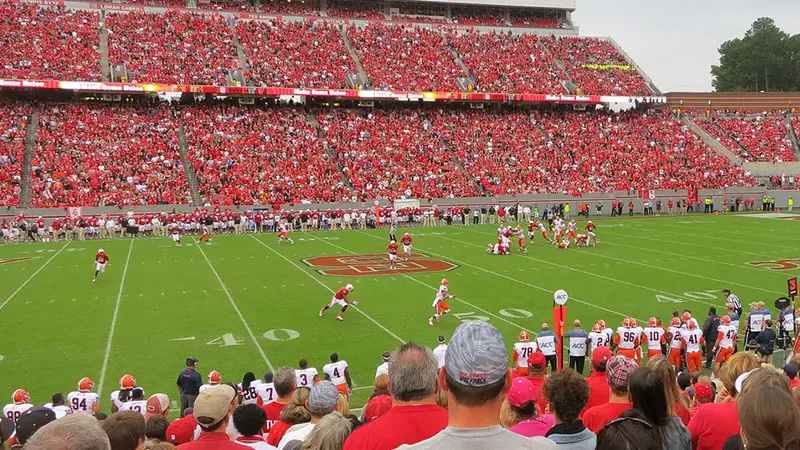In American football, defensive formations play a crucial role in determining the outcome of a game. Unlike offensive formations, which must adhere to specific rules, defensive formations offer flexibility, allowing teams to adapt to various offensive strategies.
This adaptability can make or break a game, as the right defensive setup can stifle even the most potent offenses. Defensive formations are designed to counteract the offensive team’s strengths and exploit their weaknesses.
Whether it’s the classic 4-3 defense, which balances stopping the run and the pass, or the aggressive 3-4 defense, focusing on creating pressure on the quarterback, each formation serves a specific purpose.
Understanding these formations not only enhances one’s appreciation of the game but also highlights the strategic depth involved in football.
Overview of American Football Defensive Formations
Defensive formations in American football are designed to stop the offense’s progress and regain control of the ball. They vary in complexity and adaptability.
Importance of Defensive Strategies
Defensive strategies are critical in American football as they determine how well a team can counter an opponent’s offense. Teams develop intricate schemes over seasons to maximize effectiveness.
Defensive strategies focus on stopping the ball carrier, breaking up plays, and creating turnovers. They often include blitzes, where extra players rush the quarterback to disrupt passing plays.
Key Components of Defensive Formations
Key components of defensive formations include the defensive line, linebackers, and secondary. The defensive line’s primary role is to penetrate the offensive line and tackle the ball carrier.
Linebackers provide versatility, often covering short passes, supporting the run defense, or rushing the quarterback. The secondary, consisting of cornerbacks and safeties, is tasked with defending against passing plays, covering wide receivers, and providing the last line of defense.
Each component’s effectiveness relies on coordination and the ability to adapt to offensive movements.
Common Defensive Formulations in American Football
Defensive formulations in American football are varied and complex, designed to counter different offensive strategies while maximizing defensive strengths.
4–3 Defense
The 4–3 defense consists of 4 defensive linemen and 3 linebackers. This formation balances run-stopping power and pass coverage versatility. It’s a staple in the NFL, offering flexibility in responding to various offensive tactics.
With four linemen, the defense can generate strong pressure on the quarterback, while three linebackers provide support against the run and pass.
6–1 Defense
The 6–1 defense features 6 defensive linemen and 1 linebacker. This setup focuses on overwhelming the offensive line, often used in goal-line and short-yardage situations. It’s less common due to the heavy commitment to the line of scrimmage, sacrificing coverage.
The solitary linebacker must be versatile, capable of reading plays quickly and providing crucial support.
3–4 Defense
The 3–4 defense includes 3 defensive linemen and 4 linebackers. Known for its adaptability, the 3–4 can disguise blitzes and coverages effectively. The extra linebacker offers more options for blitzing or dropping back into coverage.
This formation requires strong, agile linemen capable of occupying multiple blockers to free up linebackers to make plays.
2–5 Defense
The 2–5 defense, with 2 defensive linemen and 5 linebackers, emphasizes speed and flexibility. Often used in passing situations, this formation allows for various blitz packages and coverage schemes.
With more linebackers, the defense can quickly adapt to play-action passes and screen plays. The 2–5 is less effective against power running games due to its light front line.
4–4 Defense
The 4–4 defense comprises 4 defensive linemen and 4 linebackers. This formation is effective against the run, providing strong presence at the line of scrimmage. It’s commonly used at the high school level, balancing pressure on the quarterback with solid run support.
The four linebackers enable different blitz and coverage combinations, making it versatile.
5-3 Defense
The 5-3 defense uses 5 defensive linemen and 3 linebackers. This setup focuses on stopping the run, creating a formidable front against rushing attacks. It’s particularly useful against teams with strong running games.
The three linebackers can support gap integrity and are crucial in pass coverage against play-action passes.
6-2 Defense
The 6-2 defense consists of 6 defensive linemen and 2 linebackers. This heavy alignment is tailored for stopping the run in critical situations, such as goal-line stands.
It offers significant penetration into the backfield but is vulnerable to passing plays due to limited coverage personnel. The linebackers need to excel in reading plays and reacting swiftly.
5–2 Defense
The 5–2 defense includes 5 defensive linemen and 2 linebackers. It combines a strong defensive line presence with additional linebacker support, effective against power running teams.
Similar to the 6-2 but slightly more balanced, allowing for some flexibility in coverage. The formation relies on the linebackers to fill gaps and make plays against the pass.
Comparison of Defensive Strategies
Teams use different defensive strategies to counter various offensive threats. Each formation has unique strengths and weaknesses, making them suitable for specific situations.
Strengths and Weaknesses
Let’s compare the strengths and weaknesses of the 4-3 defense, 3-4 defense, Nickel formation, and Dime formation in American football:
4-3 Defense
The 4-3 defense utilizes four defensive linemen and three linebackers. Its strength lies in its balance between run defense and pass rush.
Strengths:
- Strong against the run due to four linemen
- Versatile pass defense with three linebackers
Weaknesses:
- Vulnerable to short passes due to fewer defensive backs
3-4 Defense
The 3-4 defense has three linemen and four linebackers. It excels in pass coverage and creating confusion for the offensive line.
Strengths:
- Provides diverse blitzing options
- Better pass coverage due to additional linebacker
Weaknesses:
- Susceptible to power running plays
- Requires athletic linebackers
Nickel Formation
The Nickel formation involves five defensive backs, making it ideal for countering passing offenses.
Strengths:
- Enhanced pass coverage
- Flexible against multiple wide receivers
Weaknesses:
- Weaker against the run
- Can be exploited by power running
Dime Formation
The Dime formation uses six defensive backs to bolster pass defense further.
Strengths:
- Superior pass coverage
- Effective in obvious passing situations
Weaknesses:
- Highly vulnerable to running plays
- Limited in rushing the passer
Situational Usage
In American football, using different defensive formations tailored to specific offensive strategies and game scenarios is crucial for maximizing effectiveness. These formations are strategically selected to counteract specific plays and enhance defensive success.
Early Downs
On early downs, teams often favor the 4-3 or 3-4 defenses. These formations offer a balance between stopping the run and defending against play-action passes.
- 4-3 Defense: Ideal for teams expecting a mix of run and pass plays.
- 3-4 Defense: Preferred if the team wants to emphasize pass coverage and flexible blitzing.
Passing Situations
During obvious passing situations, formations like Nickel and Dime become favorable. These formations provide extra defensive backs to counter multiple wide receiver sets.
- Nickel Formation: Useful when facing three wide receiver sets.
- Dime Formation: Best used in third-and-long scenarios where the pass is predictable.
Goal Line
In goal-line situations, defenses shift to formations like 6-2 or 5-3, focusing on stopping the run.
- 6-2 Defense: Focuses on maximum run-stopping power.
- 5-3 Defense: Combines run-stopping with limited pass coverage.
By strategically choosing defensive formations based on the opponent’s tendencies and specific game situations, teams enhance their chances of success. This adaptability is crucial for maintaining control and countering various offensive threats.
Evolution of Defensive Formations
Defensive formations in American football have evolved significantly to counter the changing strategies of offensive plays and to leverage advancements in player skills and team tactics.
Historical Shifts
Defensive formations in early football, such as the 7-2-2 and 7-1-2-1, used seven down linemen to counter powerful running games.
These dominated until the forward pass gained prominence, leading to the development of the 5-2 defense in the mid-1900s, which featured five linemen, two linebackers, and four defensive backs.
This evolved into variations like the Oklahoma 5-2 and eventually the professional 3-4 defense by replacing defensive ends with outside linebackers. Modern defenses, like the 4-3 and 3-4, now focus on balancing run and pass defense, prioritizing flexibility and adaptability.
Influential Coaches and Teams
Several coaches and teams have significantly evolved defensive formations in football. Innovators like Tom Landry and Buddy Ryan introduced schemes such as the Flex Defense and the 46 Defense to challenge and pressure quarterbacks.
The 1985 Chicago Bears, led by Ryan, showcased these strategies with a record-setting defense that secured a Super Bowl victory. These innovations still influence modern defensive tactics, emphasizing adaptation to offensive changes and player potential.
The transition from seven-man line defenses to formations like the 4-3 and 3-4 highlights how strategies have evolved to meet offensive trends and athletic demands, leaving a lasting impact on the game.
Choosing the Right Defensive Formation
Selecting the correct defensive formation is crucial for countering various offensive tactics and maximizing team strengths.
Factors to Consider
Several factors determine the choice of a defensive formation:
Opponent’s Offensive Scheme
Teams often adapt their formations based on the opponent’s offensive strategies. If facing a pass-heavy team, defenses might use formations with more defensive backs, such as the Nickel or Dime.
Down and Distance
The specific situation within a game can significantly influence formation choice. For example, on a third-and-long, a team may prefer a Dime Formation to enhance pass coverage, while on a third-and-short, they may use a 4-3 Formation to bolster run defense.
Personnel Strengths
Coaches consider their players’ strengths when choosing formations. A team with strong linebackers might lean toward a 3-4 Formation, utilizing four linebackers to stop the run and rush the passer.
Game Situations
Situational factors like game time remaining, score, and field position play crucial roles. In late-game scenarios with a lead, defenses often adopt prevent formations to avoid giving up big plays.
Adapting to Opponent’s Offense
Defensive formations need to adapt dynamically based on the opponent’s offensive tendencies:
Multiple Wide Receivers
When opponents deploy multiple wide receivers, defenses use formations like the Nickel and Dime. These sets add extra defensive backs for improved coverage against complex passing attacks.
Heavy Run Offense
For teams known for their strong running game, defenses might employ the 4-4 or 5-2 Formations. These formations focus on reinforcing the line of scrimmage and controlling gaps against the run.
Dual-Threat Quarterbacks
Dual-threat quarterbacks require versatile formations like the 3-3-5, which provides a mix of coverage and linebacker support to contain both passing and running threats from the quarterback.
Quick Passing Game
Against a quick passing offense, defenses may adopt the Cover 2 or Cover 3 Formations. These sets place defensive backs in zones to disrupt short, quick routes and limit yards after catch.
Frequently Asked Questions
What is the best defensive formation in American football?
There is no one-size-fits-all answer as the best defensive formation depends on the opponent’s offensive scheme and your team’s strengths. However, the 4-3 and 3-4 formations are popular due to their balance between run defense and pass coverage.
What is the difference between a 3-4 and 4-3 defense in American football?
In a 4-3 defense, there are four down linemen and three linebackers, providing a solid balance against both run and pass. A 3-4 defense has three down linemen and four linebackers, which can be more flexible in pass coverage but may be weaker against the run.
Who are some influential coaches known for developing defensive formations?
Coaches like Tom Landry and Buddy Ryan are notable for their contributions. Landry introduced the Flex Defense, while Ryan is known for creating the 46 Defense, both of which had significant impacts on the game’s defensive strategies.
How has the role of defensive formations evolved in American football?
Defensive formations have evolved to balance run defense and pass coverage better. Modern defenses, such as the Nickel or Dime packages, are more flexible and adaptive, countering a variety of offensive tactics effectively.
What factors should be considered when selecting a defensive formation in American football?
When selecting a defensive formation, consider the opponent’s offensive scheme, down and distance, personnel strengths, and specific game situations. This strategic approach ensures the defense can effectively neutralize the opposing team’s strengths.
Conclusion
American football defensive formations have evolved significantly due to the influence of key coaches and teams, adapting to opponents’ offensive strategies. The 4-3 defense is used for balanced attacks, while the 3-4 defense offers blitzing and coverage flexibility.
Modern defenses employ nickel and dime packages to counter pass-heavy offenses, and key zone defenses like Cover 2 and Cover 3 allocate deep coverage differently. Hybrid formations blend these concepts to confuse offenses.
Teams meticulously study opponents’ tendencies, and coaches stress versatility to adapt mid-game, making defensive intelligence crucial in handling dynamic offenses. This constant evolution and analysis keep defensive strategies robust against changing offensive plays.
Coaches also rely heavily on advanced analytics and video analysis to predict and counteract offensive schemes. Incorporating player strengths into schemes ensures each athlete is optimally positioned.








Ashley Hopkinson